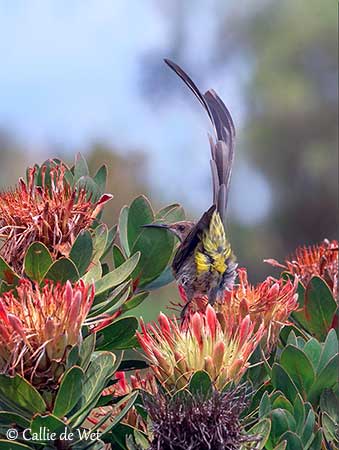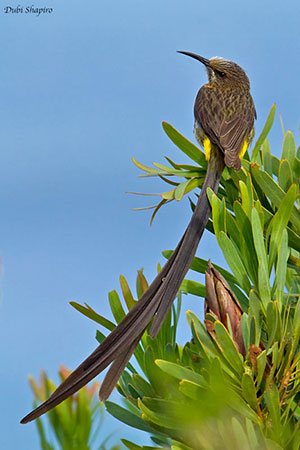
She lays 1-2 buff-coloured eggs with brown markings, and incubates alone during 17 days. She may perform distraction displays (often the “broken-wing” display) to defend the nest against predators.
The chicks are brooded by the female but both adults feed them on a diet of nectar and insects. They leave the nest about 18 days after hatching, but they still depend on adults for food for another 18-21 days. After this period, the parents chase them from the territory.
This species produces one or two broods per season. The usual predators are other birds, rodents, mongooses and snakes. The White-necked Raven is a predator for adult sugarbirds.
PROTECTION / THREATS / STATUS:
The Cape Sugarbird is common to locally common in suitable habitat, but it is threatened by habitat destruction and degradation for agriculture expansion in coastal lowland fynbos, fires and invasion by alien plants such as Acacia cyclops. It is sometimes persecuted by farmers although the damage to flowers in protea plantations is often minimal. This species is an important pollinator of proteas.
The size of the populations is placed in the band 10,000/100,000 individuals. It is suspected to be stable. The species is present in several protected areas in mountain ranges.
The Cape Sugarbird is not globally threatened, and the species is currently evaluated as Least Concern.
Fr: Promérops du Cap
Ang: Cape Sugarbird
All: Kaphonigvogel
Esp: Mielero Abejaruco de El Cabo
Ita: Zuccheriere del Capo
Nd: Kaapse Suikervogel
Sd: kapsockerfågel
Photographers:
Callie de Wet
GALLERY
Dubi Shapiro
Dubi Shapiro Photo Galleries
Ingo Waschkies
Bird Photography
Text by Nicole Bouglouan
Sources:
HANDBOOK OF THE BIRDS OF THE WORLD Vol 13 by Josep del Hoyo-Andrew Elliot-Jordi Sargatal - Lynx Edicions – ISBN: 9788496553453
BIRDS OF AFRICA SOUTH OF THE SAHARA by Ian Sinclair and Peter Ryan - Princeton University Press Princeton and Oxford - ISBN: 0691118159
ROBERTS BIRDS OF SOUTH AFRICA by G. R. Mc Lachlan and R. Liversidge – The Trustees of the John Voelcker Bird Book Fund – ISBN: 0620031182
BIRDS OF SOUTHERN AFRICA – By Ian Sinclair, Phil Hockey and Warwick Tarboton – Princeton Field Guides - Princeton and Oxford – ISBN: 0-691-09682-1
Morphological characteristics of Cape sugarbirds (Promerops cafer) from Helderberg Nature Reserve
Species in Focus – Cape Sugarbird
Sugarbirds 'poisoned to protect proteas'
Wikipedia, the free encyclopaedia
DESCRIPTION OF THE BIRD:
Biometrics:
Length: M: 37-44 cm including the tail: 22-32 cm – F: 24-29 cm including the tail: 11-15 cm
Weight: M: 30-43 g – F: 26-39 g
The Cape Sugarbird adult male has brown upperparts with blackish streaking, but the olive-green rump and uppertail-coverts show only indistinct black streaks. The very long, shaggy tail is dark brown. The upperwing is brown, and there is a wide bulge on the inner web of the fifth primary, whereas the outer webs are emarginated.
On the buffish underparts, the breast is rufous-brown with dark streaking on the lower part. Belly, flanks and undertail-coverts are bright yellow.
On the head, crown and forehead are grey-brown. We can see a conspicuous black malar stripe, bordered by a white moustachial stripe. The chin is white.
The long, decurved bill is black. The eyes are dark reddish-brown. Legs and feet are dark brown to blackish.
The female resembles male but she is smaller with shorter tail. Sha has paler breast than male. The bill is shorter too.

The immature resembles female but it is duller than adults. Breast and belly colours are not well demarcated, and the undertail-coverts are pale brown (not yellow). The tail is short.
RANGE:
The Cape Sugarbird is found in S South Africa in the Western Cape, extending into SW and S Eastern Cape.
HABITAT:
The Cape Sugarbird is restricted to the fynbos biome, between the Cederberg Mountains and the Buffalo River in the Eastern Cape.
It is present where there are flowering Proteas and Ericas, but also in gardens during summer, when Proteas are not in flower. This species is very closely associated with fynbos vegetation, well represented in Kirstenbosch in the Cape region.
CALLS AND SONGS: SOUNDS BY XENO-CANTO
The Cape Sugarbird produces harsh, grating noises. The alarm call is a rasping sound, but we can also hear a harsh, wheezing alarm note.
The song is a series of jangling metallic grating sounds, including starling-like chirps and whistles. It is described as “K-swip-chirring-ka-swip-chik-chik” with varying intensity. It is delivered from perch but also from the interior of a bush.
During the displays, the male produces mechanical noises while using both wings and tail. An audible “frrrt-frrrt-frrrt” is produced by a wide bulge on primary feathers during the flight and the aerial displays.
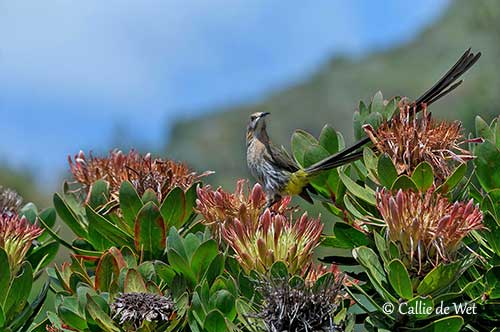
BEHAVIOUR IN THE WILD:
The Cape Sugarbird feeds primarily on nectar from flowers, especially protea species, but also Leucospermum, Mimetes and Aloe. Other plants include heaths, agaves, eucalypts and others, even introduced species.
Its long, brush-tipped tongue is well adapted to absorbing nectar. These birds are important pollinators of the fynbos, and they may visit a few hundred plants per day.
But the Cape Sugarbird also feeds on insects hawked from the air such as beetles, bees, flies, ants, wasps, aphids and moths. It also takes spiders.
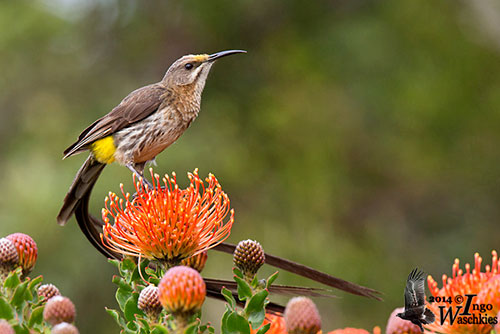
Outside of breeding season, the Cape Sugarbird often roosts in small groups.
It is resident, but during the non-breeding season, it usually performs local and short-distance movements related to the flowering period of food plants throughout the range. Movements of 27 to 44 kilometres have been recorded, occasionally more. Depending on the season, they may reach coastal plains and hillsides.
The Cape Sugarbird is a strong flier. The flight is direct, with little, if any, undulation, except during social interactions. When the bird returns to a perch, it lands with an upwards “flip-jump”. This movement is made without any apparent slowing down or breaking of the flight.
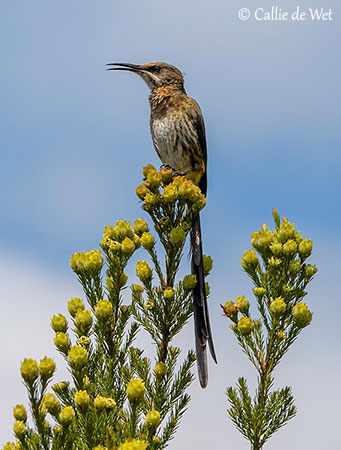
REPRODUCTION OF THIS SPECIES:
The breeding season takes place in April-July in SW, and in June-July in E of the range. This period is associated with protea flowering season.
The Cape Sugarbird is monogamous, although some extra-pair copulations may occur.
A study in Helderberg Nature Reserve, Western Cape, South Africa, shows that larger males with longer tail and longer wings, but also larger mass, could benefit from greater breeding success than smaller males, as mate choice and territory defence may be based on these ornament displays.
The female builds the nest during 5-10 days without any help from the male. She collects dead leaves (Erica) and dry grass, and moulds them with her body into a cup-shaped structure. The outer part is reinforced with plant stems, whereas the inner cup is lined with grass and brown down from protea flowers.
The nest is placed in the foliage of a bush, mainly protea but also other genera, between 0,25 and 2,4 metres above the ground. The nest is usually well hidden among the foliage and is often placed in the central part of the bush.
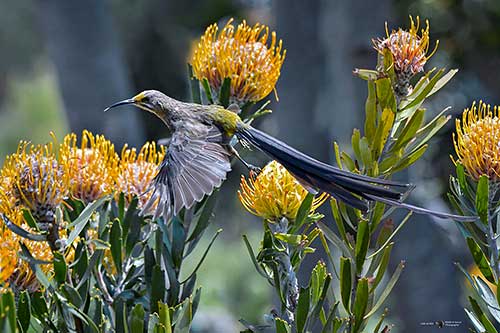
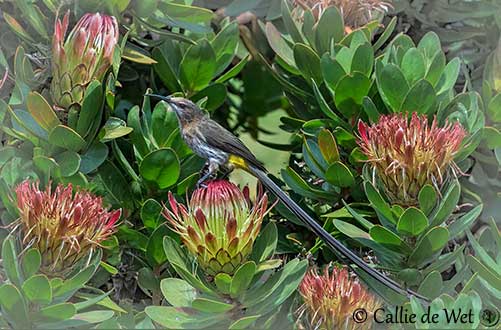
Cape Sugarbird
Promerops cafer
Passeriformes Order – Promeropidae Family
INTRODUCTION:
The Cape Sugarbird is endemic to South Africa. It is found in the fynbos biome (a small belt of natural shrubland or heathland vegetation) of the Western Cape extending into the Eastern Cape. This species is highly dependent on plants of genus Proteaceae, both for nectar and nesting sites.
It feeds primarily on nectar, but various insects are also part of its diet.
At the beginning of the breeding season, the male performs aerial displays during which the very long tail is moving up and down. The female builds the nest and incubates alone, but both parents feed the chicks.
The Cape Sugarbird is described as locally common in suitable habitat. However, the population is affected by invasion by Acacia cyclops and by fires in fynbos, involving the reduction of nesting site availability.
But currently, the species is not globally threatened.
